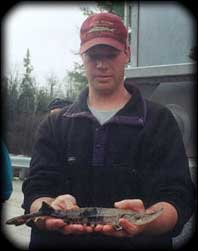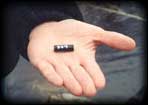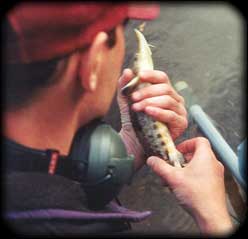2002 Lake Sturgeon Research on Black Lake
Research Studies
Whereabouts of Juvenile Lake Sturgeon
By Kregg Smith, Central Michigan University

On May 8, 2002 twelve yearling lake sturgeon with surgically implanted transmitters were returned to the Upper Black River at Red Bridge. The feisty fish ranged from 10 to 14 inches in length and weighed 120 to 210 grams.
A total of 24 sturgeon were released, however the remaining twelve fingerlings were to small for transmitters so were instead injected with a PIT tag for future identification.
Each of the transmitters have their own beep-frequency for individual identification. Generally the life expectancy of the transmitters is two months. However, the transmitters have been programmed to turn on for 3 days and off for 4 days to sustain battery life. Therefore the transmitters should remain active for four-and-half months.

Last spring, a total of 2,834 larvae were collected in the river and transported to the DNR Wolf Lake Fish Hatchery near Kalamazoo. Last fall, 913 fall fingerlings with coded wire tags ranging from 4 to 8 inches in length were reintroduced to the river.
This research project conducted by Fisheries Biologist, Kregg Smith will aid biologists in understanding the early life history of lake sturgeon as well as their migratory and distribution patterns.

To date, 8 out of 12 juveniles have been located. They have been tracked in 7 to 40 feet of water, and hold in these areas for 3 to 4 days then disperse throughout Black Lake.
Several 3 to 10 year old lake sturgeon have been netted in Black Lake and have had telemetry tags surgically implanted. Additional studies will be conducted on these juveniles.
In July, the MDNR will be conducting a 2 week adult population estimate. The results of this estimate will be reported in the Fall/Winter newsletter.
- Home Page
- Black Lake
Sturgeon Shivaree - Black Lake Watershed
- Black Lake Sturgeon Management Plan
- Committees
- Contact Us
- Directors
- Events
- Habitat Conservation
- Membership
- Newsletters
- Our History
- Photo Gallery
- Research
- Resources
- Resources for Educators
- SFT Scholarships
- Spearing Guidelines
- State Regulations
- Sturgeon Guarding
- Sturgeon Hatchery
- Sturgeon in the Classroom

